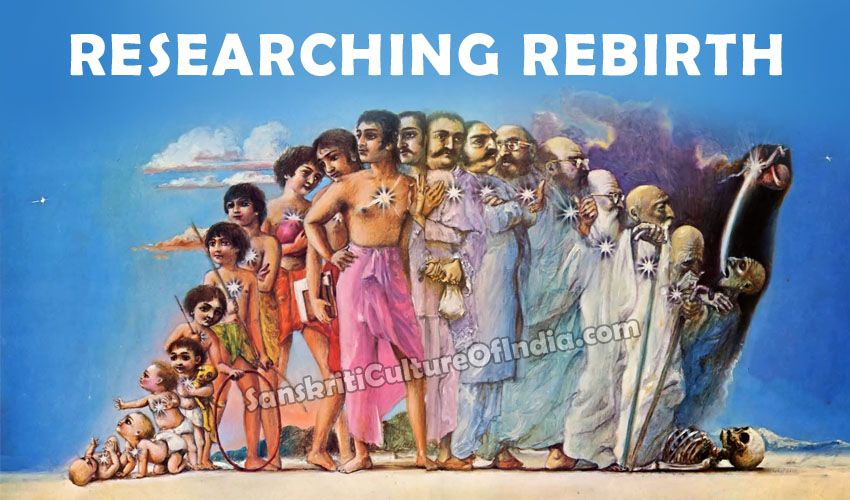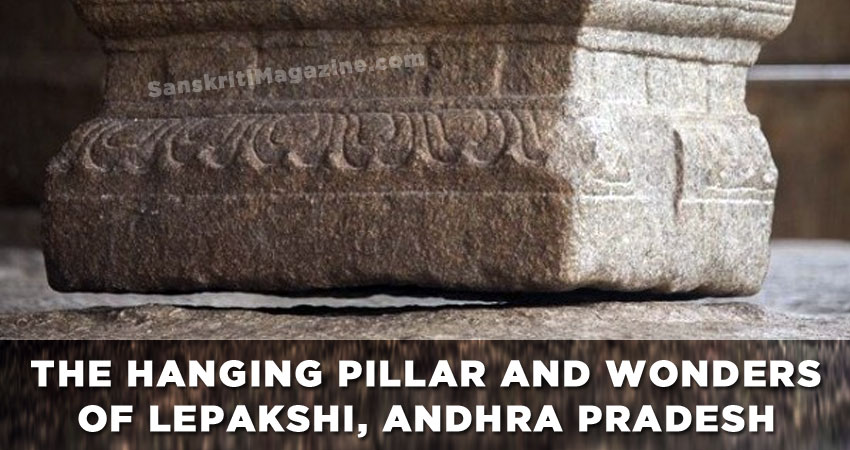The belief in rebirth is in the blood of most Indians. It is not a blind belief. There is a lot of evidence for it, as the author discovered.
I don’t remember which Bollywood movie it was. Two heroes were wooing the heroine and naturally one had to die in the end, because she could not marry both. As it happened, he indeed died. It was a sad end, because he was a nice guy. Just then a voice ended the movie, “Vapis aega – dusra roop me.” (He will come back in another form). It brought in a philosophical angle. The movie had not touched me, yet this last sentence did.
Right from the beginning of my stay in India, I felt that death is not so terrifying here. Of course here, too, there is fear of death and friends and relatives suffer when a dear one is lost. Yet death is still part of life, as it were. It is more visible than and not as final as in the west. One major reason why death is not so final and stings less is certainly the belief in rebirth. This belief is in the blood of Hindus and it is not blind belief. There are many good arguments in favour of it. The law of karma, for example, makes much more sense when it is not applied to only one life. The differences between human beings appear in a different light. Why is someone born in a palace and another in a hut? Why does one baby have loving parents and another does not? Why is one man healthy and another sick? Why is one person bright and intelligent, and another mentally retarded? Such questions cannot be answered and lead many people to despair about a just god. Yet rebirth gives a reasonable explanation. Everything is always in a flux. Who cries today, may laugh tomorrow, and who laughs today may cry tomorrow – in a continuous circle of life and death.
Since several decades, some scientists support the theory of rebirth. Though I had studied psychology, I discovered only in India that there exists a vast body of research on the subject. Some 3000 cases of rebirth have been systematically studied and are filed in the archive of the Division of Perceptual Studies of the University of Virginia, USA. Ian Stevenson who died in 2007 at the age of 88 was the initiator and main authority of the studies. Untiringly, he worked together with scientists around the globe.
Their research came to the conclusion that rebirth is the most plausible and most rational interpretation of their findings. Nothing new for Indians, yet in the west this theory got a mixed response. Many western scientists still refuse to consider the possibility of rebirth. They cannot get over their brainwashing in childhood that there is only one life and based on it, God decides whether one ends up in heaven or hell. Ian Stevenson’s greatest frustration was not that people dismissed his theories, but that in his opinion most did so without even reading the evidence he had gathered. “Either [Stevenson] is making a colossal mistake, or he will be known … as ‘the Galileo of the 20th century’,” a psychiatrist wrote about him. It shows that academics in the west are either like frogs in a well or extremely arrogant. A great part of humanity takes rebirth for granted. Yet this academic feels that Stevenson will be credited with discovering it if this theory turns out to be confirmed.
In India, Professor N.K. Chadha of Delhi University worked together with Ian Stevenson. I met him in 1990 and though he had given me an half an hour appointment, he talked for two hours as the time just flew.
Here is how he proceeds with his research:
It happens occasionally that a child, only 3 or 4 years old, claims with all conviction he is capable of to be a certain grown up person whose name is such and such, who lived and died in such and such a way. Once the professor’s team gets to know about it, they visit the child, gather info, try to identify the person who had died, and if identified, crosscheck all insider information. It is a lot of work. Some 30 visits to a far-flung village might be necessary to rule out any other possible explanations, why the child has amazing insider knowledge about some person who died before his birth.
A case is considered solved, when the person, who the child claims to have been, has been identified, all insider knowledge of the child crosschecked and no discrepancies were found. Then it can be safely assumed that the child ‘remembers’ what he knows about that person and it is considered a case of rebirth.
Prof. Chadha had examined 25 cases out of which 11 were solved at that time. The stories of those cases are fascinating – for example, the case of Titu Singh:
Titu was born in December 1983 in a village near Agra. As soon as he could speak, he started to claim that his name was Suresh Verma, that he owned a radio shop in Agra and that one evening, when he came home, he was shot dead. Further, he said, he has two sons and a wife named Uma. He spoke in detail how he died: he had driven home in his Fiat and honked so that his wife would open the gate. Suddenly, two men came running and fired at him. One bullet hit his head.
Titu was aggressive towards his ‘new’ parents, kept nagging them, for example claimed that his real mother wore not such old saris, and occasionally even threw plates around. He did not believe they were his parents. His ‘real’ parents, he stubbornly maintained, lived in Agra. Titu’s elder brother finally went to Agra and was shocked to find, indeed, a “Suresh Radio Shop” in the bazaar. He gathered information: the owner – a certain Suresh Verma – had died in August 1983, exactly in the way that Titu had described. Uma, the widow of Suresh, was curious to see the boy who claimed to be her husband. She went together with her parents in law and Suresh’s three brothers to the village of Titu.
Titu immediately ran towards ‘his parents’ and embraced them. He shyly glanced at Uma and then turned disappointed to his brothers. “Why did you come with this car and not with my Fiat?” he deplored. They had sold the Fiat after Suresh’s death.
Titu was taken to Agra. The brothers, all adults, intended to drive past the radio shop to test him. However, the four year old pounced on the driver, “Stop! Here is my shop”, he shouted. Inside, he commented on some changes that had been made after Suresh’s death.
Prof. Chadha and Dr. Antonia Mills of Virginia University examined the case over almost 4 years. They were systematic, to discover possible discrepancies and to rule out that Titu got his information through normal communication. They watched him and his reactions closely.
Once, when Prof. Chadha asked the little Titu to greet Maheash, the 35-year-old younger brother of Suresh, he refused. „He is my younger brother“, the kid claimed. The researchers came to know that the relationship between Mahesh and Suresh had been tense. This explained why Titu usually ignored Mahesh. Significantly, Mahesh was the only member of the Verma family who had some doubts: since Suresh was known in Agra and everyone knew about the murder, the parents of Titu could have fed this information to their son, maybe to get financial benefits from the Vermas who were wealthier than the Singhs, Mahesh speculated. But not for long. He changed his stand after he tested Titu himself. He grasped the wrist of Titu, Prof. Chadha narrated, and did not let go of it. “Tell me, what happened during my wedding?” he demanded to know. The boy reacted annoyed. “Why, nothing happened. I threw plates.” Now, Mahesh was also convinced. It was true. Suresh spoilt the atmosphere of the wedding when he angrily threw with plates.
The scientists discovered something else intriguing: Titu has a strange dent on his right temple. They studied the autopsy record and found that the bullet had entered Suresh’s head at exactly that place. And where the bullet had exited, there was a mole.
Strangely, or not strangely, in about four out of ten rebirth cases, the child remembered a sudden, violent death, through either accident or murder. This happened at an average age of only 34 years. The interval between death and rebirth was also significantly shorter than if the remembered person had died peacefully. In Titu’s case, it was only 5 months and on average below two years. There may be an explanation: if one suddenly and unexpectedly is pulled out from life, there may be the feeling that one is not yet finished with it and wants to come back as soon as possible to ‘continue’ living. The great interest in the previous life and the short span between death and birth may be responsible that the memory is easier accessible and that the identification with the earlier person dominates.
“Do you personally believe in rebirth?” I asked Prof Chadha. His answer was a clear “Yes”. Most Indians do not need ‘scientific’ proof. It is logical, the best possible explanation for all the differences between humans. “However, we are lucky if we get information about a case of rebirth to thoroughly research, because parents usually don’t want their children to remember an earlier birth, as there is the superstition that such children die early. In rural India there are even methods how to make children forget, if they remember, like seating them on a potter’s wheel”, Prof. Chadha explained.
The belief in rebirth (or should I say the knowledge of rebirth?) is ancient – probably as ancient as mankind. It was there not only in India, but also in ancient Greece and in early Christianity. Yet in 553 AD, Christianity condemned the belief that ‘souls exist before they are born” and indoctrinated their flock into believing, that only one life decides whether one goes for the rest of eternity as it were to heaven or hell. Today, however, – with the whip of inquisition gone – not all Christians conform to the Church. Belief in rebirth is taking root in the west. 25 per cent of Americans believe in rebirth, a poll quoted by Newsweek magazine of 31.Aug 2009 suggested. If this belief spreads further, it has the potential to undermine the ‘eternal hell’ dogma, which is a prominent tenet in Christianity as well as Islam. This would no doubt be a desirable outcome.
In spite of all the evidence for rebirth, there is no rebirth on another, higher level of truth. “Find out, whether you have been born in this life,” the sage Ramana Maharshi exhorted a visitor who wanted to know about his previous births. And when once asked, whether there is rebirth, Ramana replied, “There is rebirth and there is no rebirth.” He probably meant that on the appearance level it is there. In absolute truth, where only One Conscious Being is spread out all over, there is no place for different persons to be born and reborn.
~ by Maria Wirth, (freelance writer who has lived in India for the past 33 years)











